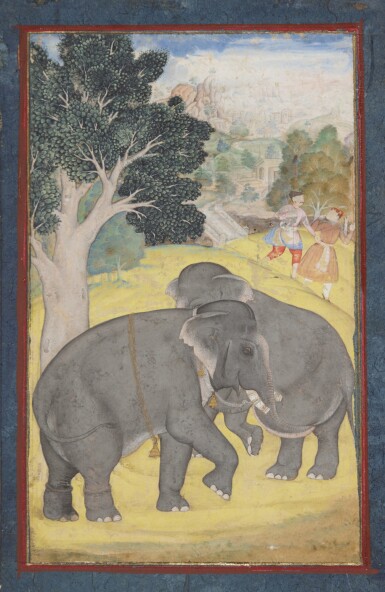Indian, Himalayan & Southeast Asian Works of Art
Indian, Himalayan & Southeast Asian Works of Art

Property of the Albright-Knox Art Gallery
Two Elephants, India, Mughal, circa 1600-50
Auction Closed
September 20, 05:33 PM GMT
Estimate
2,800 - 3,200 USD
Lot Details
Description
Property of the Albright-Knox Art Gallery
Two Elephants
India, Mughal, circa 1600-50
Opaque watercolor on paper heightened with gold
Image: 7⅜ by 4½ in. (18.7 by 11.4 cm)
Folio: 8¾ by 5¾ in. (22.2 by 14.6 cm), unframed
Arthur B. Michael Fund, 1942.
Collection of Albright-Knox Art Gallery, Buffalo.
Two elephants, perhaps mates, one with restraining chains attached to his hind legs, playfully interact as their handlers are engaged in conversation nearby. The scene is set within a grove with a bridge fording a stream in the immediate background and a town in the far distance.
The pachyderms at play are depicted with great naturalism and keen observation of detail, both of which were a prime focus in the Imperial Mughal atelier during the time of Emperor Akbar (r. 1556-1605). The style of clothing of the handlers - the short jama, trousers and turbans - as well as the overall composition, facial types and color palette, all point to an execution date around ca. 1600, which was towards the end of his reign.
Of note is the ‘atmospheric’ quality of the mist-shrouded dwelling that seems to melt into the shimmering hills in the far distance. This liminal space between reverie and reality characterizes Mughal art from the Akbar period. Also noteworthy is the careful treatment of perspective - from the arrangement of the large leafy tree in the left foreground, to the intercepting space created by the stream and viaduct in the center, terminating in the rocky hills merging with the azure sky in the far right background – which leads the viewer into the painting.
Compare the subject and composition, including the rendering of the dream-like landscape, with a late-sixteenth century illustration of an elephant with rider by artist Kesu Das in the collections of the Rijksmuseum Amsterdam, see Amina Okada, Indian Miniatures of the Mughal Court, New York, 1992, p. 100, illus. Also see a painting of ‘Emperor Akbar Riding His Favorite Elephant’ (ca. 1609–1610) from the collections of the Staatliche Museen zu Berlin, Museum für Islamische Kunst, which perfectly captures the unique fusion of mannerism and realism that was an integral part of the visual repertoire of Mughal artists in the sixteenth and seventeenth centuries.
